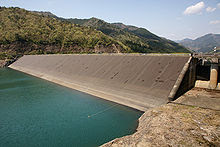Dams :
Dams are built to stop the flow of water and control the discharge. This barrier holds back water and raises its level on the upstream side. There are many dams that have a different type of function t hold and use the water of the upstream side. The different types and uses are:
Composite dams are a combination of one or more dam types where one portion is an embankment or gravity dam and another portion is used for power generation being a buttress or arch.
A great example of this is The Three Gorges Dam in China. Know More Here
- Gravity Dam
- Buttress Dam
- Arch Dam
- Embankment Dam
- Composite Dam
This types of dams help in a different area and are also created for the following objectives:
- Generation of Hydropower energy
- Providing water for irrigation facilities
- Fish farming
- Fighting Droughts
- Controlling Floods
- Water for Domestic Use
Gravity Dam :
 |
| Gravity Dam |
This is a solid concrete structure having a triangular profile to withstand against the precalculated volume of water by virtue of its weight.
Bhakra Dam is a concrete gravity dam across the Sutlej River, India.
These are the nonrigid structure which is built over wide valleys with varying foundations. The main advantage of this dam is that it can be constructed on week foundation and the impervious core is placed in the middle of the embankment body.
Buttress Dam:
 |
| Buttress Dam |
This is a modified form of gravity dam. There is a thin concrete slab which is supported by the downstream side. There are multiple reinforced columns to support the dams.
Since it has a relatively thin structure it is considered a cost-saving method.
Also Read: Bridges Types Bridges Types
Also Read: Bridges Types Bridges Types
Arch Dam :
 |
| Arch Dam |
This is an Arch Shaped solid structure made up of the concrete also they are designed such a way that the thrust force acting on the dam is transmitted to the side of the dam which they are reinforced into the wall or mountain. The thrust acts as a compressive force on the arch and thus it transmits to the sides.
There are two types:
- Constant Radius Arch
- Variable Radius Arch
We can see this type of dam in a narrow valley.
An Arch dam which has curvature both in horizontal and vertical alignment is often called a CUPOLA Dam.
The Hoover Dam is a combination of both Gravity Dam as well as Arch Dam.
Embankment Dam :
 |
| Embankment Dam |
Composite Dam :
 |
| Composite Dam |
A great example of this is The Three Gorges Dam in China. Know More Here

Comments
Post a Comment
Thank You for visiting, if you have any questions please feel free to ask: